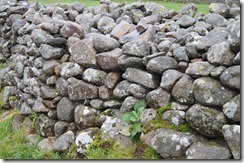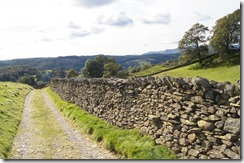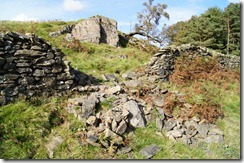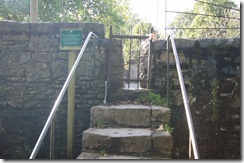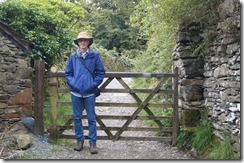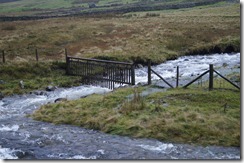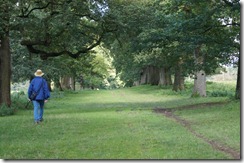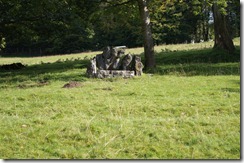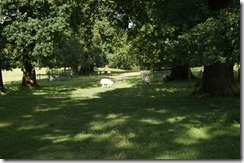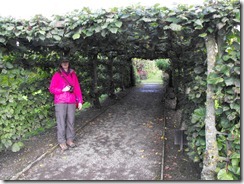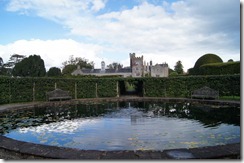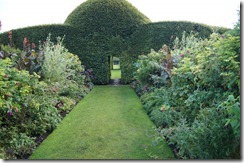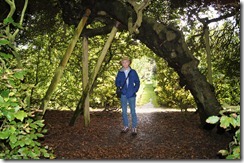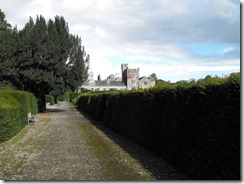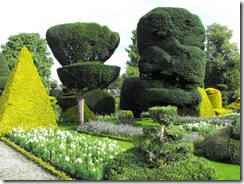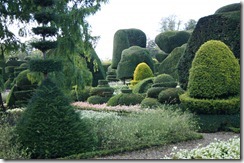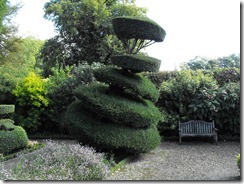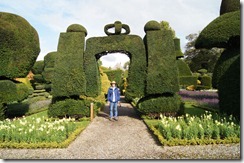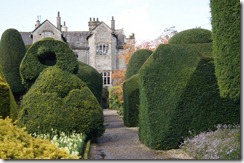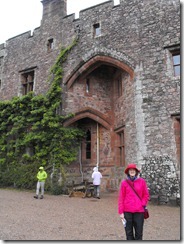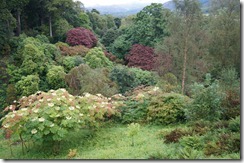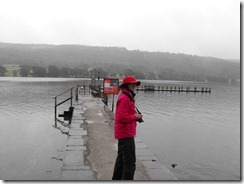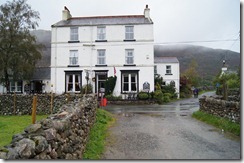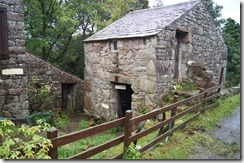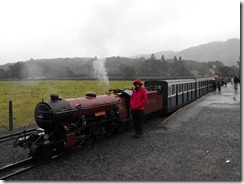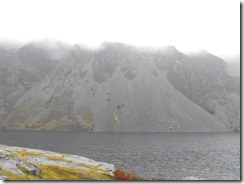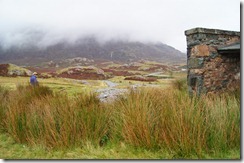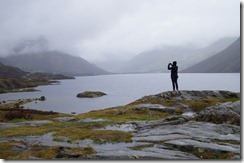Sally MacKenzie, the USA Today bestselling author of the Naked Nobility series, shares her mental and physical wanderings.
Tuesday, December 25, 2012
Merry Christmas
Merry Christmas--or happy whatever winter holiday you prefer. We were very late getting our Christmas tree up. Mr. M bought it this week from the church lot, and I started decorating it this weekend, with an assist from second son who came home on Sunday.
I thought I'd share with you my most treasured Christmas ornament. Yes, it is amazingly ugly--it looks like a ball of tinfoil in netting--but that is a good part of its charm. I'm afraid I don't know all the details of its history. As I recall, it came from my mother's family. I'm assuming my grandmother purchased it, but that seems a bit odd as I would have thought she'd have looked for something more attractive. I googled "Graf Zeppellin" and found out here that the Graf Zeppellin flew between 1928 and 1937, so I'm guessing this ornament must be about 80 years old.
It always had a prominent spot on my family's Christmas tree when I was growing up, and when my folks downsized their Christmas decorations, I grabbed it for my tree. My husband and sons groan, but every year I hang it front and center.
Sunday, December 23, 2012
Fences and gates
In our ramblings—and our many times getting lost—we became very familiar with fences and gates. On our Mountain Goat tour, I learned that the stacked stone fences can last 300 years, which means my Regency characters could have leaned against the very fences I was looking at—if my characters were real, of course. People used whatever stones were available, so if the stones had been tumbled around by a river, they were round. If they came straight from the ground, they were flat.
Here’s a fence with mostly rounded stones.
And here’s one where I’d say the stones are mostly flat.
Here’s a longer view of the flat-stone fence.
I even got some pictures of fences that had fallen down.
If you’ve got a fence, you need a way to get to the other side of it. You can go over it via a stile. (This was on Wansfell Pike.)
Or maybe you can go under it.
I’m not sure what this is, really. I did peek inside and this is what I saw.
Mostly we went through fences via a gate. There were a variety of gate types. Here is the one that got us into Levens Park, but from the park side. It was less noticeable from the highway side.
Here’s Mr. M posing so you can see how narrow the opening is.
A large, farm-style gate was relatively common. Sometimes they had a latch, but other times they closed with just a piece of rope to loop over the fence post.
A common gate—and rather ingenious, I thought—that I hadn’t seen before was one that required you to step through an opening into a box kind of arrangement and then swing the gate so that it closed up that opening and opened the other to exit. Here’s a picture that might make it clearer.
The gate is on the right. Sometimes with a backpack and camera, it was a bit of a tight fit to stand in the box area and swing the gate into the other position.
We saw an odd structure on one of our long rambles that looked like a fence across a stream. I couldn’t figure out what it was for—to corral the fish? But they could just swim through.
I asked our guide on the Mountain Goat tour, and he said it was to keep the sheep from wandering.
Here’s another that you can clearly see is part of a fence.
Monday, December 17, 2012
Levens Hall, part 4
We scampered across the highway in search of goats. The woman in the gift shop had told us the goats generally hung out to the right of the river, but the fellow at the ticket booth, who gave us a map to the park, said you couldn’t count on that. Mr. M’s patience for goat hunting was limited. The day was progressing; he didn’t think we had the hour or more needed to do the full loop around the park. So I had my fingers crossed that we weren’t off on a wild goose—er, goat--chase.
We started down the wrong path, of course, but fortunately I realized our mistake almost immediately and we were able to backtrack and get on the right path within a few minutes. If you link to the map, above, you can see where we went wrong—the sort of dotted line on the far right—and then the path we were supposed to take—the dashed line going down between the tree pairs.
You can see that this park is very different from the topiary garden, yet it was laid out by the same man. This is more like the “modern” landscape design of Capability Brown and Humphry Repton.
The River Kent was on our left.
I was hoping the goats weren’t on the other side of the river, because if they were, I suspect Mr. M would have insisted on giving up and turning back. So when we came upon some walkers heading toward us, I asked if there were goats around and they said yes, indeed, that the herd was down near the gate. I had no idea where the gate was, but it was apparently on our side of the river, so I persuaded Mr. M. to keep going.
We came upon an odd chair-like object
and the “unusual herd of black fallow deer”
as well as the ubiquitous sheep.
We were on the verge of giving up, when we finally encountered the Bagot goats. This pair patiently posed for our many photos.
Mission accomplished, Mr. M. herded me back to catch the bus to Bowness.
Monday, December 10, 2012
Levens Hall, part 3
Yes, we did finally go inside the house, but photography wasn’t allowed, so I don’t have any pictures. However, if you go the the Levens Hall web site and watch the pictures rotate through, you can see some things we saw. One of the pictures is of the drawing room and the Elizabethan overmantel. I think the carved figure shown on the web site is from the Elizabethan paneling in the small drawing room, and I confess it reminded me of George Brown’s work at Townend. The museum room had several Napoleonic artifacts, including, as best Mr. M can remember, a bottle of port. Knowing my fixation with all things Regency, he drew my attention to something—sadly,neither of us can remember what—Beau Brummel gave one of the daughters of the house.
After seeing the house, we decided to stop in the Bellingham Buttery to have a snack, and Mr. M decided to try their Morocco Ale. I had a taste, and I think it was the best of the local ales. From there we went to the gift shop, since I wanted to bring something back to our neighbor who was keeping an eye on our house while we were gone. I picked out some little gardening shears. I was so pleased, since our neighbor is a gardener. (Sadly, when I was packing to come home, I kept them in my carryon. I was thinking, “oh, I don’t want to lose this gift, so I don’t want to chance putting it in my checked bag” when I should have been thinking, “sharp object, must go in checked baggage.” The security man at the Manchester airport was very nice when he asked me if I had any “snips.” I said, no, of course not. So he searched my bag, and when he finally got to that section of my backpack and I saw them, it hit me—oh, yes I do! I felt SO stupid—and the shears went into the airport garbage.)
While in the gift shop, I saw a little pamphlet entitled: “The History of the Bagot Goats and Bagot’s Park.” Somehow I got chatting with the woman who was ringing up my doomed “snips” purchase, and she revealed that there was a part of the Levens Hall estate that had completely escaped my attention—Levens Park—and there were indeed Bagot Goats to be seen there. Well! I could not pass up a chance to see some unusual goats, even though it required a scamper across the highway. Mr. M had planned for us to take the next bus back to Windermere, but I persuaded him to delay an hour so we could go looking for goats. Which we did—but I’ll save those pictures for the next post.
Monday, December 3, 2012
Levens Hall, part 2
There was much more than the topiaries to see in the Levens Hall gardens, though things were a bit soggy from the big rain. There were leafy tunnels,
ponds with fountains,
grassy paths,
and propped up trees to stand under.
One of the things I was most excited to see was a Ha-Ha. No, I’m not laughing. This is a landscape design element I’d come across when I was researching the subject for some of my Naked books. I couldn’t quite grasp the concept, so it was great to actually see it in “action.” I had Mr. M take a picture of the sign that explains it all.
I hope you can read that if you click on it to enlarge it. Basically, it’s a way to extend the view yet keep farm animals out of the garden without a fence. According to the sign, this is the earliest example of a Ha-Ha. Here’s what it looks like.
The Ha-Ha is where you can see the line between two slightly different shades of green. If you stood at that edge and looked down, you’d see a ditch with water in it. I was tempted to try jumping down and over it to take the picture from the tree side, but was afraid that would end badly, with me wet or with a twisted ankle. I did take the picture looking down, but with no perspective, the photo really didn’t work.
After “playing” in the gardens for quite a while, we were finally ready to make our way to the house.
Sunday, November 25, 2012
Levens Hall, part 1
Our last day in the Lake District was sunny, the perfect day to enjoy the Levens Hall gardens. We had truly lucked out!
We took the same bus we took to Sizergh Castle, but this time—probably because it wasn’t raining—it was on time. Again, we changed drivers in Kendal. (I don’t seem to have managed to get any decent pictures of Kendal. It’s an old market town that we also passed through on the train.) I think the stop for Levens Hall must have been the first or second stop after the one for Sizergh Castle.
When I was researching historic homes to visit in the Lake District, it was this video that sold me on including Levens Hall. I’d forgotten that the video mentioned the Alice in Wonderland feeling, but that is exactly right. I’d meant to ask the docents in the house if Lewis Carroll had ever visited, but I forgot. Since the garden dates from the end of the 17th century, it would be possible for Lewis Carroll to have seen it. Mr. M and I took lots and lots and LOTS of pictures. Here are a few.
I love the different colors of the evergreens. One of the docents did say that it was possible to find topiaries of all the chess pieces in the garden.
There’s also a little bit of a Dr. Seuss feel—see the topiary in the back with the multiple “tufts.” Here it is, again, in the foreground.
Or this leaning fellow.
Here you can see the hall in the background.
It may be hard to tell from these pictures, but the topiaries were very large. The gardeners need scaffolding to keep them trimmed. To get a sense of the scale, I asked Mr. M, who is 6’ 3” to pose for me.
Here’s a picture of the hall from the shrubbery.
I had to laugh, too. One of my books featured “obscene shrubbery” (said in my best Monty Python voice). There wasn’t any of that in this garden, but I can now see how it would be very possible to have such horticultural decorations.
Monday, October 29, 2012
Mountain Goat, part 4
Our next stop was Muncaster, and here I confronted my main problem with tours. My purpose in signing up for this excursion was to see Muncaster, yet we had only about one and a half hours to cover everything—house, gardens, and World Owl Centre—nowhere near enough time. So I had to make some hard choices. I concluded I couldn’t do the house justice in such a short stay—and the weather was wet, so the gardens weren’t really an option—so I went for the owl show.
As part of my compromise, Mr. M and I did scamper over to take some photos of the castle and buy the house guidebook so I could see what I was missing. Here I am with the castle. Sadly the hat/coat clash is rather evident, so I apologize for offending anyone’s color sensibilities.
And another picture.
Reading through the guidebook—which was written by one of the family—it sounds like there was a pack rat (or even a hoarder) somewhere in the family tree. Of course, I understand completely. Imagine having all that room! No need to weed out possessions--much easier just to stick another box off in a corner. (Reminds me a little of a scene in my Bedding Lord Ned, actually.) Of course, when they rummage around in their basement, they come upon some priceless treasure! I just find old crayons and orphaned board game pieces.
Muncaster Castle is reputed to be haunted, so I guess it’s appropriate to be posting this close to Halloween. One of the ghosts is Thomas Skelton, or Tom Fool. The story, which you can find here, is that he would sit under a chestnut tree and, when asked directions, would send anyone he didn’t like off to follow the path down to the quicksand. Creepy!
Here I am, under Tom’s tree.
This is one of the views, looking out from about this point. I particularly liked the bridge, but I don’t know its significance, if any.
I also took a picture of a bit of one garden that was near the castle.
We then went off to learn about owls. I can’t say the program was terribly extensive, but it was fun—and we learned something that we could apply when we got back home. They had two owls at the presentation—and clearly I should have taken their pictures. One they described as a flying feather duster. He looked quite stout—but he was mostly feathers.
The tidbit we learned? That sometimes baby owls will fall out of their nests. You should leave them alone—they’ll be fine. If you bring them home, they will think they are people. And when the are returned to the wild, they will attack people, thinking they are competing for their territory. When we got back to the States, we read an article in the newspaper about a jogger who was attacked by an owl when he was out jogging two days in a row—and this was exactly the explanation.
After the show, we toured the owl center. It was a little hard to get good pictures—I’m not much of a photographer, so the fences defeated me—but I took plenty of pictures anyway. We weren’t quite sure what was up with the owl on the right. We thought he might be wet—but his companion isn’t having such a “bad feather” day.
And of course I couldn’t resist trying to get a picture of the tiny owl.
From Muncaster Castle, we headed back to Windermere and Bowness. We stopped for another photo opportunity at Coniston Water.
Mr.M took my picture—how nice of them to coordinate the sign with my hat.
One of our last stops—Malcolm pulled off the road, but we didn’t get out—was Yew Tree Farm. It played “Hill Top” in the movie Miss Potter, which neither Mr. M nor I had seen. (We got it via Netflx shortly after we got home.) The other interesting story Malcolm told us about the place had to do with its “spinning gallery.” It was the unmarried women's job to make thread. Instead of using a spinning wheel, they would drop the fiber from the spinning gallery--at least I think that's what he said--and this is where the term “spinster” came from. According to this site and this one, there is a link between spinning thread and the term for an unmarried woman.
That’s it for the Mountain Goat tour. Next up will be one of my favorite sites, Levens Hall.
Sunday, October 28, 2012
Battening down the hatches
I feel the weather sites are starting to channel their inner Chicken Little, but I guess they must know what they are talking about. In any case, it is definitely better to be prepared for disaster and have disaster not arrive than the other way round. So I've got my bread, milk, and tp. I'm printing out the book I'm currently working on (Ash's story), so I can do some revisions even if our power goes out.
Speaking out Ash's story, I've been concentrating on that recently, but I plan to get back to our Lake District adventures--assuming the sky hasn't fallen once Sandy moves on.
Stay safe, everyone!
Thursday, October 25, 2012
Mountain Goat, part 3
After leaving the Roman fort and Hardknott, we headed to Boot in Eskdale for a lunch stop. Mr. M and I weren’t in need of lunch. When we are off on our rambles, we usually have a large-ish breakfast and then a bigger than normal (for us) dinner. But Mr. M wished to try out the local ale, so we went into the pub at Brook House Inn so he could have a pint and I could have a hot chocolate. A picture of the inn:
After our beverages, we went out to have a look at the old mill. This is apparently the stables—I didn’t get a good picture of the mill, but if you follow the link, you can see pictures and read about it.
We didn’t tour the mill. Mr. M felt we were running low on time and wanted to get back to the van. Here he is on the pack horse bridge, giving me his standard “stop taking pictures and come along" look.
Behind the pub, Mr. M discovered a flock of Herdwick sheep and persuaded one to pose for a picture…well, Mr. M used his telephoto.
According to Malcolm, our guide, Herdwick sheep are the only sheep that change color over their lifetime. They are born black, turn brown after a year or so, and eventually turn gray or white—though they have the white legs and face earlier, as you see in the picture. If they live that long. Again according to Malcolm, they are mostly bred for their meat, their wool being too wiry to be used for clothing. The lambs are, ahem, selected for our dinner plates before their fleece turns brown.
We encountered sheep all over the Lake District. Herdwicks are special to the area, and Beatrix Potter is credited with doing much to save them and the Lake District from developers. There have apparently been efforts to breed them elsewhere now; if another disease such as foot-and-mouth were to strike, it could wipe out the breed if Herdwicks are concentrated in just one area.
I was very impressed that Malcolm could identify the gender of the sheep we saw—until he told us that only the ewes are allowed to graze free. The rams are kept in “bachelor flocks.” (Found that on Wikipedia here.) Another interesting thing about the Herdwicks—they learn at an early age to stay in their home territory or “heaf.” (You can read more about that if you follow the link.)
After we left Boot, we took a ride on the Ravenglass & Eskdale Steam Railway from Boot to Irton Road. It’s Victorian, so not my period, but it was fun nonetheless. You can read its history here. They have videos on the official site of the trains in motion, but there’s quite a collection of videos on youtube as well. Here’s one. I asked Mr. M to take a picture of me posing with our engine so you can see the scale of the train.
I was glad that I’m not a particularly large person when we got into the car—there’s not a lot of room. If we’d had to share with another couple, it would have gotten dicey. I have no idea where we would have put our legs.
We then moved on to Wastwater, the deepest of all the Lake District lakes. If you check out the link, you’ll see mention of the Screes. Here is Mr. M’s picture.
Wastwater was very beautiful. I suppose we would have seen more if the clouds weren’t so low, but they did add a dramatic touch.
That’s Mr. M in blue, but I have to admit I don’t know what that structure is.
Looking one way
and looking the other.
Yes, I got a little camera happy, but, as you know if you followed the link, Wastwater was voted Britain’s most beautiful view. The figure in the picture above is one of the other two Americans, a mother and daughter from the other Washington.
I think there’s only one more Mountain Goat adventure to come.

